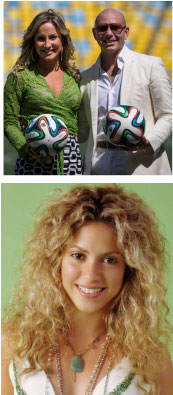 respectively. The closing act was Shakira, who is from Colombia.
The public may not necessarily know the differences among those countries, and since Pitbull, Jennifer Lopez, and Shakira have international recognition, it made sense for them to perform.
The lesson here is that your audience doesn’t need every single detail to be perfect; referencing things in a way that coincides with your customers’ perceptions is more important than being 100% accurate.
6. Remove barriers, but set boundaries
Head to FIFA.com and you’ll find stats on every match, player, and country involved in the Cup. Hundreds of pages of information are available to be referenced in news and review articles around the world.
FIFA makes it easy for writers to create content about the World Cup, also requiring attribution for the source of the information, which further cements the FIFA and World Cup brands.
Be prepared for your brand to get shared, and help your fans to do so. Product reviews and articles drive the best traffic, and having the right assets available will have your brand ready for when those user-generated content is created.
7. Create snippets worth remembering
Chants, songs, memes, images—all parts of the World Cup that stick with us. From the official World Cup song to the thousands of memes made for Tim Howard after his masterful performance against Portugal, the World Cup was ubiquitous.
You too can build memorable snippets that represent your brand well, and use them as a way to remain top-of-mind among your audiences. Snippets can be songs, jingles, quizzes, videos... anything that is fun and short.
8. Create content tailored for your audience
The promotional video for the United States soccer team featured celebrities calling the nation to action, with small clips of soccer shown in between. The promotional video for Germany, on the other hand, was composed entirely of football clips woven together with music.
The marketers responsible for these videos understood their audiences.
In Germany, football is a way of life, kids train to play the sport from the age of six, and the team members are considered national heroes. Their video focused on the pure sport and did not need celebrities.
9. Use what you have in various ways
Highlights, team profiles, slide shows, and reviews—all ways that the World Cup effectively re-used its most valuable asset—the games themselves. Each game is sliced and diced and redistributed in various ways to maximize the impact.
Similarly, your best marketing pieces can be cut up, rebuilt, and republished on different platforms to maximize reach. For example, a great article and be turned into a SlideShare, recorded as a video, and turned into an infographic. Each piece will reach a different segment of the audience. Once you know you’ve got a winner, milk it for all its worth.
10. Partner up with complementary people
A list of drinks from each country, comedians mocking the art of flopping, World Cup-inspired Adidas websites—those are just a few of the ways the World Cup expanded its reach by forging partnerships with different industries.
Every business has complimentary companies (other businesses that reach a similar customer group, but with a different product). Forging partnerships with complementary businesses is great for both parties, because you can share audiences and content. |

